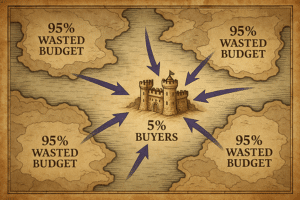How digital marketing can improve the customer experience (3/4)
<<Previous article: Old school marketing: communication saturation and blind steering
Beyond “old school” marketing, what to do? The new rules of marketing engagement
We think the rules have changed in terms of marketing, including how a brand can engage its consumers or prospects. Adobe recently showed in a study that marketing executives believe marketing has changed more in the last two years than in 50 years. The emergence of “inbound marketing” marks a new age of marketing.
1 : To be found
It is necessary to progressively move from a logic where the brand goes to its prospects and interrupts them to deliver a message, to a logic where prospects come to the brand because it produces interesting content and disseminates it in places where the prospect is likely to pass.
This is the domain of “Content Marketing” and SEO (SEO, SEA, SMO). The paradigm shift comes from the fact that at any given moment, there are bound to be people who need your services. And these people are probably looking for a solution to their problem in the digital world. You need to cross their path and make sure they see your content and find it interesting.
Attracting prospects with content is not an easy task: you have to tell an attention-grabbing story, add eye-catching images (or videos or presentations), distribute it on the right networks according to your audience, amplify your message to your audience, take care of the SEO of your content… and then check which content works best to draw the right conclusions.
2: Establish personalized and lasting conversations
Easier said than done, but it already involves obtaining the prospect’s permission to discuss with them (opt-in and opt-out concept via a subscription page), listening to where he is in his thought cycle and pushing content that is interesting for him, based on his behavior. The brand’s communication must be triggered by the prospect. Here, we have to move from a communication whose only goal is to sell, sell, sell, to a communication where we put ourselves in the prospect’s shoes and we try to make him progress, educate him, entertain him (the “Lead Nurturing” domain).
Within the first few seconds of the content appearing, the prospect must have a clear understanding of what they can gain by reading it.
3: Contextualize your communication
Targeting is critical to the success of your communication. According to a study conducted by Marketo, your audience’s level of engagement can be increased eightfold through targeting.
But the days when only age, company size or income were used for targeting are over; the same person can have radically different expectations depending on their path in the buying process: at the beginning I will try to understand how to solve my problem, at the end I will try to compare brands or products.
Communication must be triggered by the prospect. This means “listening” to their “online body language“: which pages do they visit? What content does he download? Do they attend events? Or webinars? What keywords do they use in search engines before coming to your site?
All these elements can be analyzed and evaluated to give your prospect a maturity score and to identify their interests. And thus send him the interesting content at the moment he wants it.
4: Be consistent in your conversation on all channels
The prospect has the power. They no longer want the brand to impose a communication channel on them. They want to be able to start a conversation on one channel (the website for example) and continue where he left off on another channel (the store, following the example). This requires the brand to share information about its prospect, his habits, his preferences, his maturity on all channels, including the status of the current conversation.
For example, if I spent time configuring my dream car on a car manufacturer’s website, I wouldn’t understand if my configuration wasn’t available when I got to the dealership. This requires an omnichannel strategy.
5: Base marketing decisions on facts
Among the holy grail for marketing teams are:
- identifying which content has the most impact,
- which landing page has the highest conversion rate,
- being able to run an A/B test on a form simply and automatically keep the one that works best,
- prove to management the contribution of marketing to the company’s turnover,
- measure in real time the return on investment of different marketing programs…
All of this comes up against the hard reality that even if you manage to share information between sales (the opportunities that generated revenue) and marketing (the programs that generated these opportunities), there is still the main difficulty, especially in B2B:
- a sale usually requires 7 touches for a lead, which can represent several marketing programs (the web, the engagement program, the webinar…). How to dispatch the revenue on these different programs?
- A sale can involve between 5 and 21 people who have themselves participated in different programs!
This can become a real headache without the proper processes and technology.
Our recommendation
The transition from the old world to the new cannot be done abruptly. For a company that is still massively oriented towards outbound, and that would like to switch to an inbound strategy, it is necessary to sequence the efforts over time. One of the major differences between outbound and inbound is in the results:
- Outbound results are almost immediate, but they don’t last long. It is necessary to continuously launch campaigns to generate leads. But the persistence of the marketing action (cold call, email, mail) has a very short life span.
- Those of inbound marketing take time to arrive but are cumulative over time. Your content will initially have few readers, but as it is referenced in search engines and networks, it will gain audience, and in return, improve its visibility. The more you make content that will be cross-referenced with your other content, the more it will amplify the movement.
It is therefore necessary to mix outbound and inbound at first, and to progressively decrease the outbound as the first results of the inbound are obtained. Another key to a successful digital marketing strategy is to equip yourself with a marketing automation solution. It is an indispensable solution to coordinate all these initiatives and to relieve the teams of repetitive and tedious tasks. It is also the only way to easily measure marketing ROI. An example of what a Marketing Automation solution can do for you?






